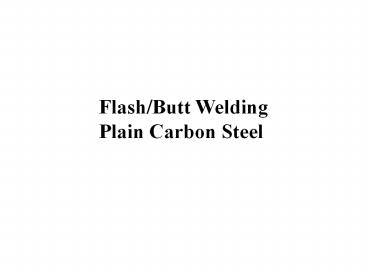Flash/Butt Welding - PowerPoint PPT Presentation
Title:
Flash/Butt Welding
Description:
Flash/Butt Welding Plain Carbon Steel Materials with higher electrical resistance will have more heating and lower thermal conductivity will retain the heat at the ... – PowerPoint PPT presentation
Number of Views:3529
Avg rating:3.0/5.0
Title: Flash/Butt Welding
1
Flash/Butt Welding Plain Carbon Steel
2
Flash Welding of Plain Carbon Steel
- Learning Activities
- Look up Keywords
- View Slides
- Read Notes,
- Listen to lecture
- Do on-line workbook
- Do homework
- Lesson Objectives
- When you finish this lesson you will understand
- The flash and butt welding process for plain
carbon steel - The weld parameters which must be controlled to
get good welds - Typical flash/butt weld defects
Keywords Flash Weld (AC), Butt Weld (DC),
Flashing Current, Upset Current, Upset Force,
Upset Velocity, Upset Distance, Forging
Temperature, Linear Platen Motion, Parabolic
Platen Motion, Continuous Acceleration Platen
Motion, Flat Spots, Penetrators
3
Savage, Flash Welding, Welding Journal March 1962
4
Applications
Wheel Truck Rims Ball Bearing Raceways Bar
Welding Strip Welding During Continuous
Processing In Steel Mills Pipelines
5
(No Transcript)
6
Schematic of Typical Flash Weld Cycle
Savage, Flash Welding, Welding Journal March 1962
7
(No Transcript)
8
0
.05
.15
.10
Initial Flashing
Partial Burn-off Stage 1 - Heat Soaking
Increased Burn-off Stage 2 - Steady State
Excessive Burn-off Stage 3 - Heat out
9
Best Region For Upset
Nippes, Temp Dist During Flash Welding, Welding
Journal, Dec 1951
10
In Steady State, the Heat into the HAZ Equals
the Heat Out
Stage 3 Occurs When More Heat Flows Out than is
Flowing In
11
Upset in the Steady State - Stage 2 Region
Forge Temp
At Upset
Short Time After
Long Time After
12
Nippes, Cooling Rates in Flash Welding, Welding
Journal, July 1959
13
At Moment Of Upset Short Time Thereafter
Temperature vs. Time As a Function Of Distance
From Interface At Moment of Upset
14
Nippes, Cooling Rates in Flash Welding, Welding
Journal, July 1959
15
Questions?
- Turn to the person sitting next to you and
discuss (1 min.) - The night shift flash weld operator said that he
felt the platen velocity was too fast so he
slowed it down. What do you think will result by
this change?
16
Factors Which Effect Extent of Stable Stage 2
- Material Electrical Thermal Conductivity
- Platen Motion During Flashing
- Initial Clamping Distance
- Preheat
- Material Geometry
17
Electrical Thermal Conductivity
HAZ
High Resistance More I2R Heating Low Thermal
Conductivity Less Heat Out
- More Rapid Heating
- Longer Stage 2
- Higher Temperature
- Wider HAZ
18
Wide HAZ
Narrow HAZ
Oxides Trapped At Interface
Oxides Forced To Flashing
19
Platen Motion
Continuous Acceleration
Linear
Parabolic
Continuous Acceleration lead to Stub Out
20
Nippes, Temp Dist During Flash Welding, Welding
Journal, Dec 1951
21
Linear Flashing - Effect of Increased Velocity
Higher Velocity
22
Parabolic Flashing
Nippes, Temp Dist During Flash Welding, Welding
Journal, Dec 1951
23
Temperature Comparison of Linear and Parabolic
Flashing
Nippes, Temp Dist During Flash Welding, Welding
Journal, Dec 1951
24
Initial Clamping Distance
Closer Initial Clamping
- Shorter Stage 2
- More Burnoff to Establish Steady State
- Steeper Temperature Gradient
25
Effect of Preheat
Beneficial
Larger HAZ
26
Thicker Material
Thicker Material is more of a Heat Sink
27
Questions?
- Turn to the person sitting next to you and
discuss (1 min.) - OK, we went back to the faster platen motion and
told the night shift guy to keep his hands off,
but the weld still seems to be too cold. What
would you suggest?
28
DC Butt Welding
29
Schematic of Typical Butt Weld Cycle
Medar Technical Literature
30
Questions?
- Turn to the person sitting next to you and
discuss (1 min.) - Because the part are first touching as DC
current is applied in butt welding, large current
levels occur immediately. How would welding
steels containing large manganese sulfide
inclusions be effected by this?
31
FLASH/BUTT WELD DISCONTINUITIES
- MECHNICAL
- Misalignment
- Poor Scarfing
- Die Burns
- HEAT AFFECTED ZONE
- Turned Up Fibers (Hook Cracks)
- HAZ Softening
- CENTERLINE
- Cold Weld
- Flat Spots / Penetrators
- Pinholes
- Porosity
- Cracking
32
Misalignment
Notch Stress Riser
33
Poor Scarfing
Notch
Thin Section
34
Die Burns
Arcing
Crack
Martensite
35
Turned Up Fibers - Hook Cracks
36
Hook Cracks
37
Hardness Loss
38
Cold Weld
Cold Weld
39
Flat Spots Penetrators in Flash Welds
40
(No Transcript)
41
(No Transcript)
42
(No Transcript)
43
Factors During Upset Which Reduce Defects
- Upset Velocity
- Upset Current
- Upset Force
- Upset Distance
- Material Hot Strength/Chemistry
44
Upset Velocity
Higher Velocity Helps extrude Centerline Oxides
Out 1. Oxides Are Present Because Melting Points
are high 2. Oxides Tend to Solidify or Harden
and Get entrapped at the Interface 3. Rapid
Velocity Helps Get Them Moving
45
Upset Current
- Advantages
- Keeps Heat at Center Line During Upset
- Keeps Oxides Fluid
- Aids In Forcing Oxides Out
- Disadvantages
- Excess Heating Can Produce Excess Upset
- More HAZ Fiber Turn Up
46
Upset Force
Generally Use Maximum Available (Too Light a
Force May Entrap Oxides)
Upset Distance
Need Enough Upset to Squeeze all Oxides Out (Rule
of Thumb 1/2 to 1.25 times the thickness)
47
Material Hot Strength/Chemistry
- Materials with higher hot strength require
- higher force during upset
- Materials producing refractory oxides or
nitrides - require higher upset distance to squeeze them
out
48
Homework

